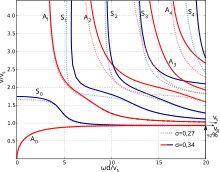Lamb wave
Lamb waves (after Horace Lamb ) are vibrations of a plate in which deflections occur both in the direction of propagation ( longitudinal ) and perpendicular ( transversal ) to it. Therefore Lamb waves are mixed pressure and shear waves . They are named after Horace Lamb, who presented a closed analytical solution for this wave type in 1917. Depending on the excitation frequency, Lamb waves occur in at least two basic modes, one symmetrical and one anti-symmetrical:
- In the case of symmetrical Lamb waves, at one position of the plate, the top and bottom side move away from the plate center (or towards it)
- In the case of antisymmetric Lamb waves, the top side moves away from the center and the bottom side moves towards the center (both upwards or both downwards).
Lamb waves are dispersive, i.e. H. their speed of propagation depends on the excitation frequency and the plate thickness. The group and phase velocities are shown in dispersion diagrams.
Influence of the wavelength
In the case of Lamb waves of short wavelength, several oscillation modes occur for one wavelength ; these are for symmetrical and antisymmetrical Lamb waves with S0, S1, S2 ... or. A0, A1, A2… numbered consecutively. In the case of the higher modes, several mutually oscillating areas occur in the thickness direction of the plate.
If the wavelength is much smaller than the thickness of the plate , the Lamb wave becomes the superposition of two Rayleigh waves , one at the top and one at the bottom of the plate. Especially in this case one speaks of Lamb-Rayleigh waves.

Lamb waves are dispersive , i.e. H. the propagation speed ( phase speed and group speed ) depends on the wavelength. In the limiting case of very small wavelengths (Rayleigh waves), with symmetrical Lamb waves also at very large wavelengths, the speed of propagation becomes almost constant.
application
Lamb waves are used technically for the ultrasonic testing of thin-walled structures, for example for the examination of sheet metal in the maintenance of aircraft . Research is currently being carried out into the applicability of Lamb waves in structural health monitoring (SHM) of composite materials , as it has been recognized that S0 modes convert to A0 modes at asymmetrical interferences in the fiber composite .
history
Lamb waves were first described mathematically correctly by Horace Lamb in 1917; based on earlier work by John William Strutt, 3rd Baron Rayleigh . Significant work was later carried out by Igor Aleksandrovich Viktorov ; DC Worlton generated and demonstrated these waves experimentally in the megahertz range for the first time, thus making them possible to use them for material testing .
literature
- H. Lamb: On Waves in an Elastic Plate. In: Proceedings of the Royal Society of London . Series A, vol. 93, pp. 114–128, 1917 ( online ; PDF; 1.3 MB)
- DC Worlton: Experimental Confirmation of Lamb Waves at Megacycle Frequencies . Journal of Applied Physics, Vol. 32 (6), pp. 967-971, 1961.
- IA Viktorov: Rayleigh and Lamb Waves . Plenum Press, New York 1970.
Web links
- Animation of Lamb waves (avi video) at University of South Carolina
Individual evidence
- ↑ G. Mook., C. Willberg, U. Gabbert, J. Pohl: DACH Conference - Mon. 3.C.2, Graz. 17th-19th September 2012, conversion of Lamb wave modes in CFRP plates. ; PDF; 33 kB









